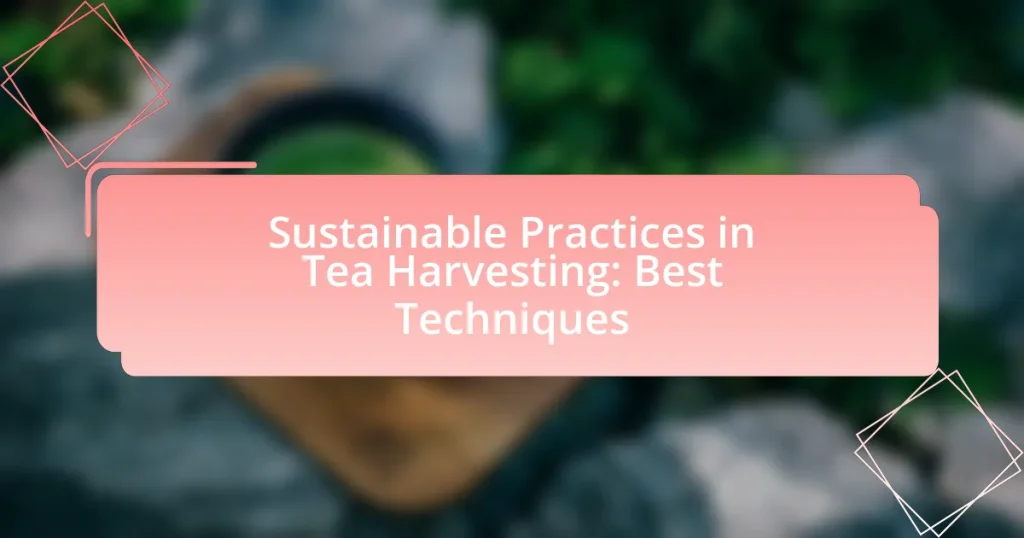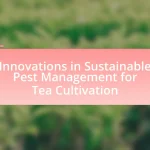Sustainable practices in tea harvesting focus on techniques that reduce environmental impact while enhancing social and economic benefits for local communities. Key methods include organic farming, shade-grown cultivation, and manual harvesting, which collectively promote biodiversity, soil health, and fair labor conditions. The article explores the importance of sustainability in tea production, the environmental consequences of traditional harvesting methods, and the principles that guide sustainable practices. Additionally, it highlights innovative technologies, community initiatives, and the challenges faced by farmers in adopting these practices, providing practical tips for effective implementation.
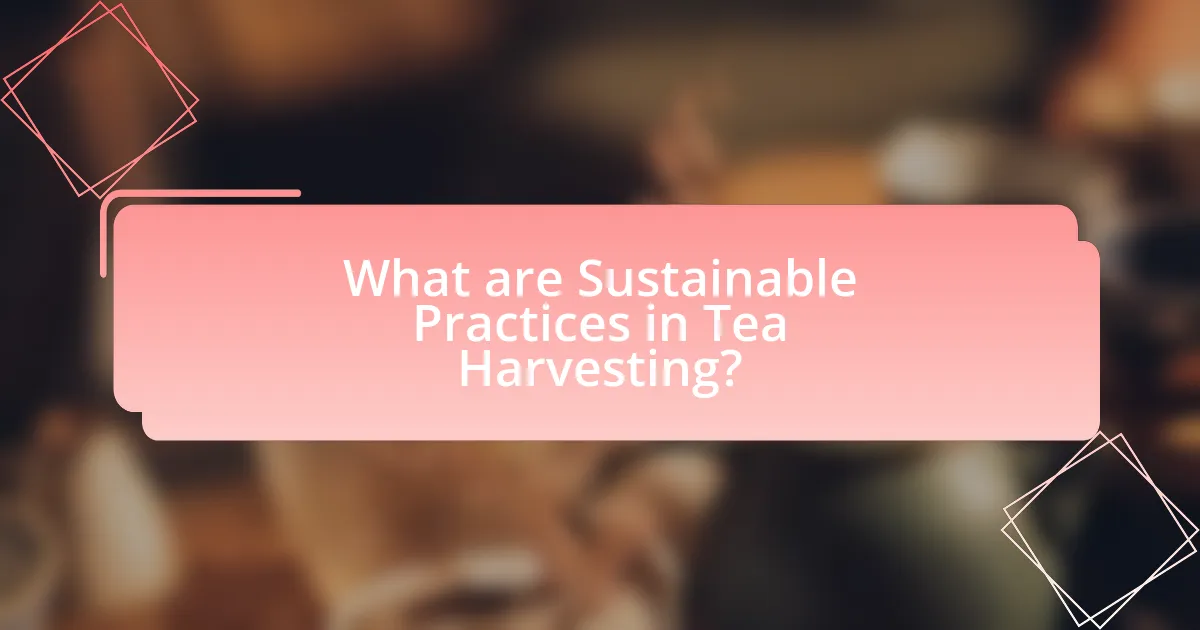
What are Sustainable Practices in Tea Harvesting?
Sustainable practices in tea harvesting include techniques that minimize environmental impact while promoting social and economic benefits for local communities. These practices involve organic farming methods, which eliminate synthetic pesticides and fertilizers, thereby preserving soil health and biodiversity. Additionally, shade-grown tea cultivation enhances ecosystem balance by providing habitats for various species and reducing the need for irrigation.
Furthermore, employing manual harvesting techniques ensures selective picking, which maintains the quality of the tea and reduces waste. Certification programs, such as Rainforest Alliance and Fair Trade, also promote sustainable practices by ensuring fair wages and working conditions for laborers, thus supporting community development. These practices collectively contribute to the long-term viability of tea production and the health of the surrounding environment.
Why is sustainability important in tea harvesting?
Sustainability is important in tea harvesting because it ensures the long-term viability of tea production while minimizing environmental impact. Sustainable practices, such as organic farming and agroforestry, help preserve biodiversity, improve soil health, and reduce chemical usage, which can lead to healthier ecosystems. For instance, a study published in the Journal of Sustainable Agriculture found that organic tea farms had 30% higher biodiversity compared to conventional farms, demonstrating the ecological benefits of sustainable methods. Additionally, sustainable tea harvesting practices can enhance the quality of tea, as healthier plants produce better flavors, ultimately benefiting both producers and consumers.
What environmental impacts does traditional tea harvesting have?
Traditional tea harvesting has several environmental impacts, including deforestation, soil erosion, and loss of biodiversity. The process often involves clearing large areas of land, which leads to habitat destruction for various species. For instance, in regions like Assam, India, extensive tea plantations have resulted in significant forest loss, impacting local wildlife and ecosystems. Additionally, the use of chemical fertilizers and pesticides in traditional practices can contaminate soil and water sources, further harming the environment. Studies have shown that these practices contribute to soil degradation, reducing its fertility and leading to increased erosion, which can affect surrounding agricultural areas.
How does sustainable tea harvesting benefit local communities?
Sustainable tea harvesting benefits local communities by promoting economic stability and environmental health. This practice ensures fair wages and working conditions for tea workers, which enhances their quality of life. For instance, according to the Fair Trade Foundation, certified tea producers often receive a premium price for their products, allowing them to invest in community projects such as schools and healthcare facilities. Additionally, sustainable methods reduce environmental degradation, preserving local ecosystems that communities rely on for resources, thus fostering long-term agricultural viability and food security.
What are the key principles of sustainable tea harvesting?
The key principles of sustainable tea harvesting include environmental conservation, social equity, and economic viability. Environmental conservation focuses on maintaining biodiversity, minimizing chemical use, and protecting water resources, which are essential for healthy tea ecosystems. Social equity emphasizes fair labor practices, community engagement, and ensuring that workers receive fair wages and safe working conditions. Economic viability ensures that tea production remains profitable for farmers while promoting sustainable practices that do not deplete natural resources. These principles are supported by various certifications, such as Rainforest Alliance and Fair Trade, which promote responsible farming practices and provide guidelines for sustainable tea production.
How do these principles promote ecological balance?
Sustainable practices in tea harvesting promote ecological balance by minimizing environmental impact and preserving biodiversity. Techniques such as selective harvesting reduce soil erosion and maintain the integrity of the ecosystem, allowing for natural regeneration of plant species. Additionally, organic farming methods eliminate harmful pesticides, which protects beneficial insects and promotes a healthy soil microbiome. Research indicates that farms employing sustainable practices can enhance local wildlife populations, as seen in a study published in the Journal of Applied Ecology, which found that organic tea farms supported 30% more bird species compared to conventional farms. This biodiversity contributes to ecological stability, ensuring that ecosystems can withstand environmental changes.
What role does biodiversity play in sustainable tea practices?
Biodiversity plays a crucial role in sustainable tea practices by enhancing ecosystem resilience and promoting natural pest control. Diverse ecosystems support a variety of species that contribute to soil health, pollination, and the overall balance of the environment, which is essential for tea cultivation. For instance, studies have shown that tea farms with higher biodiversity levels experience reduced pest outbreaks, leading to lower pesticide use and healthier crops. Additionally, maintaining a variety of plant species around tea plantations can improve soil fertility and water retention, further supporting sustainable agricultural practices.
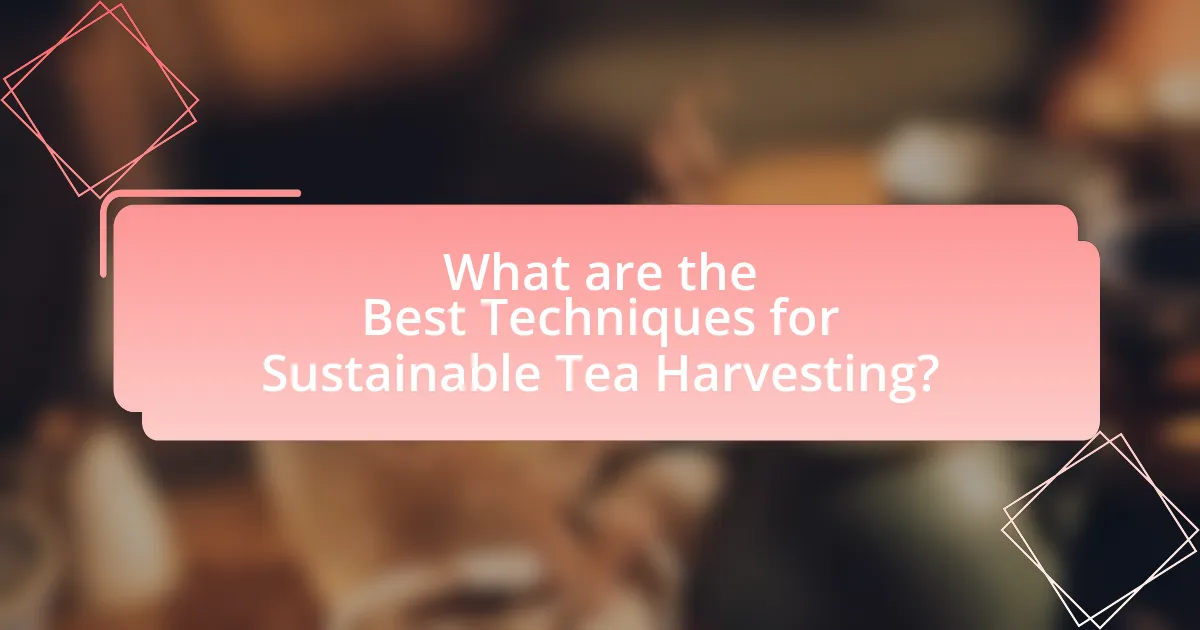
What are the Best Techniques for Sustainable Tea Harvesting?
The best techniques for sustainable tea harvesting include selective picking, organic farming practices, and agroforestry integration. Selective picking involves harvesting only the top two leaves and a bud, which promotes plant health and allows for continued growth. Organic farming practices eliminate synthetic pesticides and fertilizers, fostering a healthier ecosystem and improving soil quality. Agroforestry integration combines tea cultivation with tree planting, enhancing biodiversity and providing shade, which can improve tea quality and reduce water usage. These techniques are supported by studies showing that sustainable practices can increase yield and improve environmental health, such as research published in the Journal of Sustainable Agriculture, which highlights the benefits of organic methods in tea production.
How can organic farming techniques be applied to tea harvesting?
Organic farming techniques can be applied to tea harvesting by utilizing natural pest control methods, promoting soil health through composting, and implementing crop rotation. These practices enhance the quality of tea while minimizing chemical inputs. For instance, using beneficial insects like ladybugs can effectively manage pests without synthetic pesticides, which aligns with organic principles. Additionally, composting enriches the soil with nutrients, fostering healthier tea plants and improving yield. Research indicates that organic tea farms can produce comparable yields to conventional farms while maintaining biodiversity and soil integrity, as shown in studies conducted by the International Federation of Organic Agriculture Movements.
What are the benefits of using organic fertilizers in tea cultivation?
The benefits of using organic fertilizers in tea cultivation include improved soil health, enhanced nutrient availability, and increased biodiversity. Organic fertilizers, such as compost and green manure, enrich the soil with essential nutrients while promoting beneficial microbial activity. This leads to better water retention and soil structure, which are crucial for tea plants. Studies have shown that tea cultivated with organic fertilizers can yield higher quality leaves, as these fertilizers contribute to the development of complex flavors and aromas. Additionally, organic practices reduce the risk of chemical runoff, thereby protecting surrounding ecosystems and promoting sustainability in tea farming.
How does pest management differ in organic tea farming?
Pest management in organic tea farming primarily relies on natural methods rather than synthetic chemicals. Organic tea farmers utilize techniques such as crop rotation, the introduction of beneficial insects, and the application of organic pesticides derived from natural sources to control pest populations. For instance, neem oil, a natural pesticide, is commonly used to deter pests without harming the ecosystem. This approach not only minimizes chemical residues on tea leaves but also promotes biodiversity and soil health, aligning with sustainable agricultural practices.
What innovative technologies support sustainable tea harvesting?
Innovative technologies that support sustainable tea harvesting include precision agriculture, drone technology, and automated harvesting systems. Precision agriculture utilizes data analytics and sensors to optimize resource use, reducing water and fertilizer consumption while enhancing yield quality. Drone technology enables aerial monitoring of tea plantations, allowing farmers to assess crop health and identify areas needing attention, which minimizes pesticide use. Automated harvesting systems, such as robotic pickers, increase efficiency and reduce labor costs, while also ensuring that only mature leaves are harvested, promoting plant health and sustainability. These technologies collectively contribute to more environmentally friendly and economically viable tea production practices.
How can precision agriculture improve tea yield sustainably?
Precision agriculture can improve tea yield sustainably by utilizing data-driven technologies to optimize resource use and enhance crop management. This approach allows farmers to monitor soil health, moisture levels, and pest populations in real-time, leading to more efficient irrigation and targeted pest control. For instance, studies have shown that precision irrigation can reduce water usage by up to 30% while maintaining or increasing yield levels. Additionally, the use of drones and satellite imagery enables farmers to assess crop health and growth patterns, facilitating timely interventions that can boost productivity without compromising environmental integrity.
What role does data analytics play in sustainable tea farming?
Data analytics plays a crucial role in sustainable tea farming by enabling farmers to make informed decisions that enhance productivity while minimizing environmental impact. Through the analysis of data related to soil health, weather patterns, and crop yields, farmers can optimize resource use, such as water and fertilizers, leading to more sustainable practices. For instance, a study published in the Journal of Cleaner Production found that data-driven precision agriculture techniques can reduce water usage by up to 30% while maintaining crop yields. This demonstrates that data analytics not only supports sustainable farming practices but also contributes to economic viability in the tea industry.
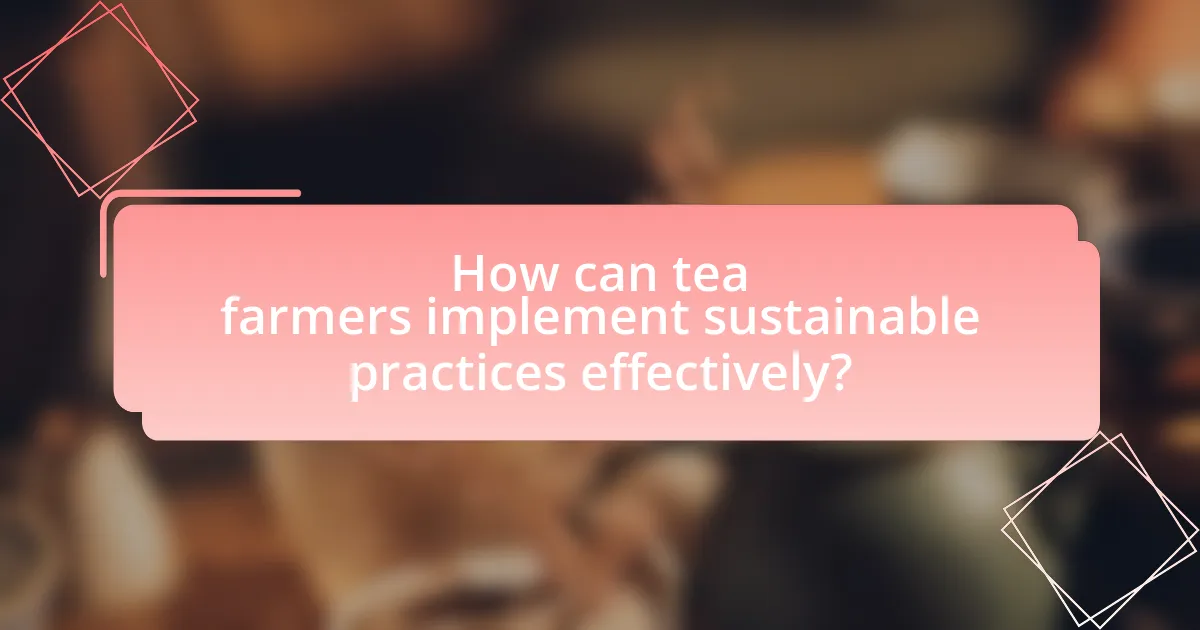
How can tea farmers implement sustainable practices effectively?
Tea farmers can implement sustainable practices effectively by adopting agroecological methods, which enhance biodiversity and soil health. These methods include intercropping tea with nitrogen-fixing plants, reducing chemical inputs, and utilizing organic fertilizers. Research indicates that agroecological practices can increase yields by up to 30% while decreasing reliance on synthetic pesticides (Source: “Agroecology: A Global Movement for Food Security and Sustainability,” by Miguel Altieri). Additionally, implementing water conservation techniques, such as rainwater harvesting and drip irrigation, can optimize water use and reduce waste. Studies show that these practices not only improve environmental sustainability but also enhance the economic viability of tea farming by lowering costs and increasing resilience to climate change.
What training and resources are available for tea farmers?
Tea farmers have access to various training programs and resources aimed at improving sustainable practices in tea harvesting. Organizations such as the Rainforest Alliance and Fair Trade provide training on sustainable agricultural techniques, pest management, and soil health. Additionally, local agricultural extension services often offer workshops and seminars focused on best practices for tea cultivation. Research from the International Tea Committee highlights that these training initiatives can lead to increased yields and improved quality of tea, thereby enhancing farmers’ livelihoods.
How can farmers access sustainable farming certifications?
Farmers can access sustainable farming certifications by applying through recognized certification bodies that evaluate their farming practices against established sustainability standards. These certification bodies, such as the Rainforest Alliance, Fair Trade, and USDA Organic, provide guidelines and criteria that farmers must meet to qualify. For instance, the Rainforest Alliance requires adherence to environmental and social standards, which are verified through on-site audits. Additionally, farmers can participate in training programs offered by these organizations to better understand the certification process and improve their practices.
What community initiatives support sustainable tea harvesting?
Community initiatives that support sustainable tea harvesting include cooperative farming models, organic certification programs, and educational workshops for farmers. These initiatives promote environmentally friendly practices, such as reducing pesticide use and enhancing biodiversity. For example, the Rainforest Alliance works with tea farmers to implement sustainable practices that protect ecosystems while improving livelihoods. Additionally, local cooperatives often provide training on sustainable agricultural techniques, which can lead to higher quality tea and better market access. These efforts collectively contribute to the sustainability of tea harvesting by fostering community engagement and environmental stewardship.
What challenges do farmers face in adopting sustainable practices?
Farmers face several challenges in adopting sustainable practices, including financial constraints, lack of knowledge, and limited access to resources. Financially, the initial investment for sustainable technologies and practices can be high, deterring farmers from making the switch. Additionally, many farmers may lack the necessary knowledge or training to implement these practices effectively, leading to uncertainty about their benefits. Limited access to resources, such as organic inputs or sustainable farming equipment, further complicates the transition. According to a study published in the Journal of Sustainable Agriculture, 60% of farmers cited financial limitations as a primary barrier to adopting sustainable practices, highlighting the significant impact of economic factors on their decisions.
How can financial constraints impact the transition to sustainability?
Financial constraints can significantly hinder the transition to sustainability by limiting the resources available for implementing eco-friendly practices. When financial resources are scarce, tea producers may prioritize short-term profits over long-term sustainability initiatives, such as investing in organic farming methods or renewable energy sources. For instance, a study by the International Institute for Environment and Development found that smallholder farmers often lack access to capital, which restricts their ability to adopt sustainable agricultural techniques. This financial limitation can lead to continued reliance on harmful pesticides and unsustainable harvesting methods, ultimately undermining efforts to achieve environmental sustainability in tea production.
What are the common misconceptions about sustainable tea harvesting?
Common misconceptions about sustainable tea harvesting include the belief that all organic tea is sustainably harvested, that sustainable practices are too costly for small farmers, and that sustainable tea does not require any chemical inputs. While organic certification often indicates environmentally friendly practices, it does not guarantee sustainable harvesting methods, as some organic teas may still contribute to deforestation or biodiversity loss. Additionally, studies show that sustainable practices can be economically viable for small farmers, as they often lead to improved soil health and higher quality yields over time. Lastly, sustainable tea harvesting can involve minimal chemical inputs, focusing instead on natural pest management and soil enrichment techniques, which are essential for maintaining ecosystem balance.
What are practical tips for implementing sustainable practices in tea harvesting?
Practical tips for implementing sustainable practices in tea harvesting include adopting organic farming methods, using integrated pest management, and ensuring fair labor practices. Organic farming methods reduce chemical inputs, promoting soil health and biodiversity, which is essential for sustainable tea production. Integrated pest management minimizes pesticide use by employing natural predators and crop rotation, thereby protecting the ecosystem. Additionally, ensuring fair labor practices supports the well-being of workers and contributes to the social sustainability of tea harvesting. These practices are supported by research indicating that organic tea farming can lead to higher biodiversity and healthier ecosystems, as noted in studies published by the International Journal of Tea Science.
